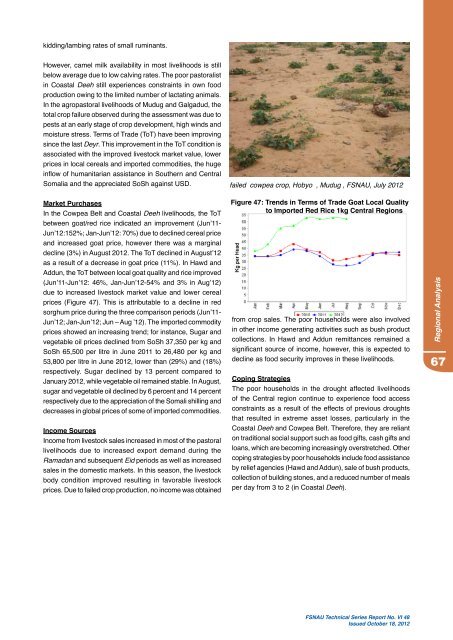Fsnau-Post-Gu-2012-Technical-Report
Fsnau-Post-Gu-2012-Technical-Report
Fsnau-Post-Gu-2012-Technical-Report
You also want an ePaper? Increase the reach of your titles
YUMPU automatically turns print PDFs into web optimized ePapers that Google loves.
kidding/lambing rates of small ruminants.<br />
However, camel milk availability in most livelihoods is still<br />
below average due to low calving rates. The poor pastoralist<br />
in Coastal Deeh still experiences constraints in own food<br />
production owing to the limited number of lactating animals.<br />
In the agropastoral livelihoods of Mudug and Galgadud, the<br />
total crop failure observed during the assessment was due to<br />
pests at an early stage of crop development, high winds and<br />
moisture stress. Terms of Trade (ToT) have been improving<br />
since the last Deyr. This improvement in the ToT condition is<br />
associated with the improved livestock market value, lower<br />
prices in local cereals and imported commodities, the huge<br />
inflow of humanitarian assistance in Southern and Central<br />
Somalia and the appreciated SoSh against USD.<br />
Market Purchases<br />
In the Cowpea Belt and Coastal Deeh livelihoods, the ToT<br />
between goat/red rice indicated an improvement (Jun’11-<br />
Jun’12:152%; Jan-Jun’12: 70%) due to declined cereal price<br />
and increased goat price, however there was a marginal<br />
decline (3%) in August <strong>2012</strong>. The ToT declined in August’12<br />
as a result of a decrease in goat price (11%). In Hawd and<br />
Addun, the ToT between local goat quality and rice improved<br />
(Jun’11-Jun’12: 46%, Jan-Jun’12-54% and 3% in Aug’12)<br />
due to increased livestock market value and lower cereal<br />
prices (Figure 47). This is attributable to a decline in red<br />
sorghum price during the three comparison periods (Jun’11-<br />
Jun’12; Jan-Jun’12; Jun – Aug ’12). The imported commodity<br />
prices showed an increasing trend; for instance, Sugar and<br />
vegetable oil prices declined from SoSh 37,350 per kg and<br />
SoSh 65,500 per litre in June 2011 to 26,480 per kg and<br />
53,800 per litre in June <strong>2012</strong>, lower than (29%) and (18%)<br />
respectively. Sugar declined by 13 percent compared to<br />
January <strong>2012</strong>, while vegetable oil remained stable. In August,<br />
sugar and vegetable oil declined by 6 percent and 14 percent<br />
respectively due to the appreciation of the Somali shilling and<br />
decreases in global prices of some of imported commodities.<br />
Income Sources<br />
Income from livestock sales increased in most of the pastoral<br />
livelihoods due to increased export demand during the<br />
Ramadan and subsequent Eid periods as well as increased<br />
sales in the domestic markets. In this season, the livestock<br />
body condition improved resulting in favorable livestock<br />
prices. Due to failed crop production, no income was obtained<br />
failed cowpea crop, Hobyo , Mudug , FSNAU, July <strong>2012</strong><br />
Figure 47: Trends in Terms of Trade Goat Local Quality<br />
to Imported Red Rice 1kg Central Regions<br />
from crop sales. The poor households were also involved<br />
in other income generating activities such as bush product<br />
collections. In Hawd and Addun remittances remained a<br />
significant source of income, however, this is expected to<br />
decline as food security improves in these livelihoods.<br />
Coping Strategies<br />
The poor households in the drought affected livelihoods<br />
of the Central region continue to experience food access<br />
constraints as a result of the effects of previous droughts<br />
that resulted in extreme asset losses, particularly in the<br />
Coastal Deeh and Cowpea Belt. Therefore, they are reliant<br />
on traditional social support such as food gifts, cash gifts and<br />
loans, which are becoming increasingly overstretched. Other<br />
coping strategies by poor households include food assistance<br />
by relief agencies (Hawd and Addun), sale of bush products,<br />
collection of building stones, and a reduced number of meals<br />
per day from 3 to 2 (in Coastal Deeh).<br />
FSNAU <strong>Technical</strong> Series <strong>Report</strong> No. VI 48<br />
Issued October 18, <strong>2012</strong><br />
Regional Analysis<br />
67


